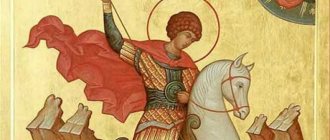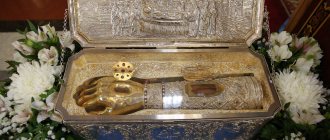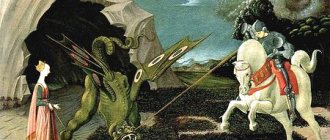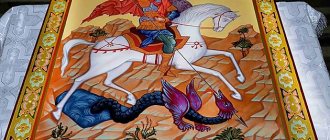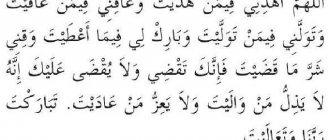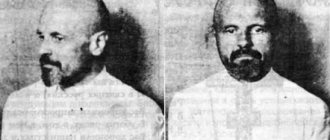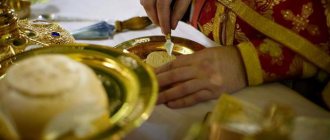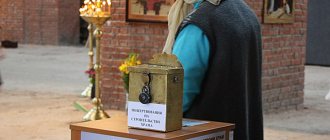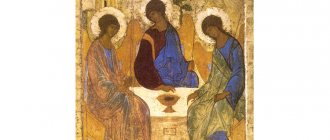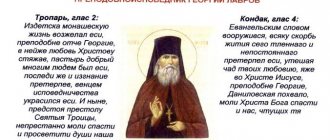- Legends about the life of St. George the Victorious
- Legends about George the Serpent Fighter
- What does Saint George the Victorious protect from?
- Prayer to St. George the Victorious from enemies visible and invisible
Every Christian has his own heavenly protector - they call on him in difficult moments of life, asking for support and admonition. This could be a martyr who bears the same name that was given to you in baptism, a righteous person whose day of veneration falls on your birthday, or an ascetic for whom you have a special spiritual affection. But in order to choose a revered patron, you need to know his life and accomplished feats. Our article will introduce you to the history of one of the most famous Orthodox saints, tell you what they pray to St. George the Victorious and who he protects.
Description of the holy image
To fully understand the meaning of the iconographic composition, one should turn to the life of the passion-bearer. George the Victorious was born at the end of the 3rd century and was a native of the Palestinian city of Lydda (present-day Lod, Israel). His father professed the teachings of Christ, for which he was brutally executed, and his pregnant mother fled to Palestine. There she gave birth to a son, whom she later gave a good education.
Icon of St. George the Victorious
The boy grew up strong and strong, and also had a sharp mind. All these qualities served him as a pass to the imperial army, where the future saint served in military service for several years. When persecution of Christians began under the leadership of Diocletian, George tried to convince the emperor to convert the ruler to Christianity. However, being an ardent pagan, he remained adamant, and instead advised the warrior to reconsider his views on life. When the soldier refused, the cruel tyrant ordered him to be tortured until he renounced Christ. But even during terrible torment, the passion-bearer did not betray the Lord. The sophisticated torture lasted a week, and after that St. George the Victorious was executed by beheading.
For his strong faith, perseverance and devotion to God, the great martyr was elevated to sainthood. Since then, he has been depicted as a rider on a snow-white horse, slaying a creeping reptile with a sharp spear. This is the most common image, symbolizing victory over evil. There are also icons where the monk holds a cross or sits on a throne. His face can be found on the flag of Moscow, since St. George the Victorious is the patron saint of the Russian capital.
Unfortunately, the location of the original miraculous image is still unknown. The last mention of it dates back to 1649. According to the ancient manuscript, the holy face belonged to the Vladyka Convent. Its dimensions were 75x75 cm, the frame was decorated with gold and silver, and also inlaid with precious stones. A candlestick was attached to the bottom of the robe. Legends say that the candle standing in front of the icon of the passion-bearer spontaneously lit on the eve of the raid of the Mongol-Tatar yoke.
Although the original was lost, several copies have survived. The most famous one is kept in the Vladychny Monastery and streams myrrh from time to time. The remaining lists belong to:
- Church of the Great Martyr George the Victorious in Starye Luchniki;
- St. George's Cathedral of the Odintsovo deanery;
- Church of St. George in the village. Monino;
- a temple erected in the name of the passion-bearer in the Moscow region.
Icon. Perv. half of the 14th century Byzantine Museum, Athens
St. George of the shoulder. Con. XII - early XIII century. Monastery of St. Catherine on Mount Sinai
Icon. 1130-1140 Moscow
The miraculous icon is honored several times a year:
- the 6th of May;
- November 16 and 23;
- 9th December.
Life
Great Martyr George was the son of rich and pious parents who raised him in the Christian faith. He was born in the city of Beirut (in ancient times - Belit) at the foot of the Lebanese mountains.
Having entered military service, the Great Martyr George stood out among other soldiers for his intelligence, courage, physical strength, military posture and beauty. Having soon reached the rank of commander of a thousand, St. George became the favorite of Emperor Diocletian. Diocletian was a talented ruler, but a fanatical supporter of the Roman gods. Having set himself the goal of reviving dying paganism in the Roman Empire, he went down in history as one of the most cruel persecutors of Christians.
Having once heard in court an inhuman sentence about the extermination of Christians, St. George was inflamed with compassion for them. Anticipating that suffering also awaited him, George distributed his property to the poor, set his slaves free, appeared to Diocletian and, declaring himself a Christian, accused him of cruelty and injustice. Speech of St. George was full of strong and convincing objections to the imperial order to persecute Christians.
After unsuccessful persuasion to renounce Christ, the emperor ordered the saint to be subjected to various tortures. St. George was imprisoned, where he was laid on his back on the ground, his feet were put in stocks, and a heavy stone was placed on his chest. But St. George bravely endured suffering and glorified the Lord. Then George’s tormentors began to become more sophisticated in their cruelty. They beat the saint with ox sinews, wheeled him around, threw him into quicklime, and forced him to run in boots with sharp nails inside. The holy martyr endured everything patiently. In the end, the emperor ordered the saint's head to be cut off with a sword. Thus the holy sufferer departed to Christ in Nicomedia in 303.
The Great Martyr George is also called the Victorious for his courage and spiritual victory over his tormentors who could not force him to renounce Christianity, as well as for his miraculous help to people in danger. The relics of Saint George the Victorious were placed in the Palestinian city of Lida, in a temple bearing his name, and his head was kept in Rome in a temple also dedicated to him.
On the icons of St. George is depicted sitting on a white horse and slaying a serpent with a spear. This image is based on legend and refers to the posthumous miracles of the Holy Great Martyr George. They say that not far from the place where St. George in the city of Beirut, there lived a snake in the lake, which often devoured the people of that area. What kind of animal it was - a boa constrictor, a crocodile or a large lizard - is unknown.
To quench the fury of the serpent, the superstitious people of that area began to regularly give him a young man or a girl by lot to be devoured. One day the lot fell on the daughter of the ruler of that area. She was taken to the shore of the lake and tied, where she waited in horror for the snake to appear.
When the beast began to approach her, a bright young man suddenly appeared on a white horse, struck the snake with a spear and saved the girl. This young man was the Holy Great Martyr George. With such a miraculous phenomenon, he stopped the destruction of young men and women within Beirut and converted the inhabitants of that country, who had previously been pagans, to Christ.
It can be assumed that the appearance of St. George on horseback to protect the inhabitants from the serpent, as well as the miraculous revival of the farmer’s only ox described in the life, served as the reason for the veneration of St. George as the patron of cattle breeding and protector from predatory animals.
In pre-revolutionary times, on the day of remembrance of St. George the Victorious, residents of Russian villages for the first time after a cold winter drove their cattle out to pasture, performing a prayer service to the holy great martyr and sprinkling houses and animals with holy water. The Day of the Great Martyr George is also popularly called “Yuriev Day”; on this day, before the reign of Boris Godunov, peasants could move to another landowner.
St. George is the patron saint of the army. The image of St. George the Victorious on a horse symbolizes the victory over the devil - the “ancient serpent” (Rev. 12:3, 20:2). This image was included in the ancient coat of arms of the city of Moscow.
Symbol of Russia
The figure of St. George slaying a dragon with a spear was used for many centuries as an integral part of the sovereign Russian coat of arms. As far as archaeological finds allow us to understand, the image of St. George was in fact the first Russian coat of arms - even before the time when the official coat of arms appeared in Russia.
This image has been found on Russian seals and coins in all eras. Saint George has been considered the patron saint of Moscow since the time of Dmitry Donskoy. With the advent of the Romanov dynasty, the image of St. George fighting the dragon was included in the coat of arms of the Russian state as the personification of the role of the Christian state - protecting the oppressed from the power of the serpent, the dragon.
George and the dragon
In principle, this story alone could make the name of St. George revered and famous. Indeed, this story is worthy of books and films. An apocalyptic story, one might say, and it is no coincidence that it has always seen the history of not only the past, but also the future of the Apocalypse. But there was one episode in the life of George (at least this is what legends and tradition say) that became significant in the identification of George and in the semantic, prophetic load that it contained. This, of course, is the image of St. George slaying the dragon. And this image (with small or large deviations from the canon) will be exaggerated countless times in European art.
In all images of George you will see a shield, spear or sword, cloak or chain mail, belt and boots. In other words, he appears fully armed. This is a reflection of the counsel the Apostle Paul wrote, which he especially strongly recommends to Christians of late times: Ephesians 6:13-17
“For this purpose take up the whole armor of God, so that you may be able to withstand on the evil day and, having done everything, to stand. Stand therefore, having your loins girded with truth, and having put on the breastplate of righteousness, and having shod your feet with the preparation of the gospel of peace; and above all, take the shield of faith, with which you will be able to quench all the fiery arrows of the evil one; and take the helmet of salvation, and the sword of the Spirit, which is the Word of God.”
Let us take this into account that the weapon of a Christian warrior, which is St. George, is first and foremost a spiritual weapon. The artistic depiction of this weapon, as in the Bible, is associated with weapons of physical warfare. But it is not necessarily like that. In iconography, as in Christian art in general, deep internal symbols are hidden behind external attributes. These symbols (in this case, weapons of spiritual warfare) do not eliminate the external meaning of the symbol - military weapons. But they are not limited to them.
Interpretation of symbols
In Rus', the image of St. George the Victorious became, as already mentioned, a national symbol. A symbol whose meaning many researchers seek to link with certain Russian victories. Or with the victory over Diocletian the dragon. But in reality, this symbol is aimed primarily at the future - a prophetic orientation. He represents - in an extremely condensed form - the future of Russia (at least - as it seemed to the Russian people of that time).
Let's continue reading the symbolism of the images. Here is an interesting passage that precedes those words of the Apostle Paul about weapons of war, which I already quoted: Ephesians 6:10-13:
“Finally, my brothers, be strong in the Lord and in the might of His might. Put on the whole armor of God, so that you can stand against the wiles of the devil, because our struggle is not against flesh and blood, but against the principalities, against the powers, against the rulers of the darkness of this world, against the spiritual forces of wickedness in the heavenly places.”
These words not only define the type of weapon that the holy warrior uses, but also indicate the enemy. And this enemy is not Khazaria, as some believe, not the Mongols, and not states and peoples in general - past, present or future. The enemy is the dragon - the world ruler of the spirits of evil in the heavens. It is with him that Rus' is waging its main struggle. It is in this, and not in some kind of national war, that Rus' gains its main victory.
This symbolism was far from abstract for the Russian people. People believed and knew that the Antichrist had yet to come, and express himself in human likeness, and gather around himself a dragon-state (prophetic beasts and monsters, dragons in biblical symbolism, represent states and empires).
Dappled white horse
Unlike us today, in their legends, people of the Christian era, Christian culture, invested much more into the image of St. George the Victorious than we do today. The fact is that, along with other symbols such as fish, shepherd, sheep, cross, etc. the symbol of a rider on a horse became the image of Jesus Christ Himself. Indeed, the similarities become obvious if you read how the book of Revelation presents the coming of Jesus Christ, rider on a white horse:
11 And I saw heaven opened, and behold, a white horse, and he who sat on it was called Faithful and True, Who judges in righteousness and makes war. 12 His eyes are like a flame of fire, and on His head are many crowns. He had a written name that no one knew except Himself. 13He was clothed in clothing stained with blood. His name is: “The Word of God.” 14 And the armies of heaven followed Him on white horses, clothed in fine linen, white and clean. 15 Out of His mouth comes a sharp sword, to smite the nations. He shepherds them with a rod of iron; He tramples the winepress of the wrath and wrath of God Almighty. 16 His name is written on his robe and on his thigh: “King of kings and Lord of lords.” (Rev 19:11-16)
Moreover, the story of the dragon and the angel who chains him is also present in the book of Revelation: (Rev 20:1-3)
“And I saw an angel descending from heaven, having the key of the abyss and a great chain in his hand. He took the dragon, the ancient serpent, who is the devil and Satan, and bound him for a thousand years, and cast him into the abyss, and shut him up, and put a seal over him, so that he would no longer deceive the nations until the thousand years were fulfilled.”
Thus, the range of the image of St. George the Victorious is determined between the story of one warrior who killed a monstrous animal, and the story of the Second, Victorious Coming of Jesus Christ - a rider on a white horse. This double vision marks the boundaries of interpretation, but does not limit it to only two options. At the very heart of history lies the early Christians' understanding of the events of not only the Advent itself, but also the Apocalyptic events that preceded it.
Let's take a closer look. The Russian horseman does not have a halo, and his clothes are road clothes, not formal white. And the appearance of the rider is not as formidable and shining as Christ. Not God and Man in One. No. Just a man. Just a king . Just the last Russian Tsar. Simply - Holding on a horse.
The horse of the rider in symbolic emblems is also no longer white - but, if you follow the strictest canons of pictorial symbolism, it is dappled white and gray. I hope I won’t offend anyone if I say that Russia in the symbolism of St. George is the saint’s white horse with gray apples. Don't be offended, friends - this is a good image. States in Biblical symbolism are usually presented as predatory animals, bloodthirsty, rushing at each other. A horse is a completely different animal. This is a noble “animal” carrying a king rider. The last one, or as he was also called, the White Russian Tsar. The king about whom many prophecies speak, to which I have addressed many times before.
George the Victorious - peaceful warrior
Remember that George was at one time a close friend of Emperor Diocletian. You may have heard that Diocletian resigned early (immediately after the execution of George). And when a few years later a delegation of Roman patricians was sent to him with a request to return to the emperorship, he simply said:
"Nonsense! If they saw what kind of cabbage grows in my garden, they wouldn’t pester me with all sorts of nonsense.” Perhaps the emperor learned this from his friend George, whom he betrayed. And whom he often remembered - after his resignation? One way or another, George did not come to fight the dragon. He was driving by. I was going home to grow my garden.
How can Russia, other than in a military conflict, defeat the dragon? After all, the dragon, as we said, has the ability to incarnate into entire states and peoples and persecute dissidents. Isn’t Russia’s strength in its strategic weapons? Not in its political and economic power? Yes, the power of Russia, its military power is like a formidable spear in the hands of St. George. But this is not her main weapon.
Russia's main weapon has not yet been developed or released. This is prayer. With prayer, according to legend, St. George tied the dragon - before the royal daughter threw a leash on him. With prayer and only prayer can Russia defeat the dragon. Weapons are only expensive camouflage, which is necessary until people - all Russians, or very many - arm themselves with faith and prayer. This was precisely the secret weapon of St. George.
Prophetic image of the king
As I have already mentioned, in Russia since ancient times the image of George has been perceived both as the image of Rus' itself and as the image of its last - white - tsar. It is interesting that in most Russian images of St. George he is presented (unlike Western images of the same saint) without a halo. This is not an accident, not an oversight. This is an indication that, by and large, this story is not about the saint of the past, but about the king of the future. About the last Russian Tsar, about whom I have already spoken and written so much.
So, this last king, together with all the people, will have to win this victory. Will this victory be bought at the cost of great losses on the battlefield? Will she follow the “slay the dragon” scenario? Or will it be a spiritual victory, when the dragon is defeated not on the battlefield, not with worldly weapons, but with the weapons of the Spirit? Defeated in yourself first? Defeated in Russia? Inside us?
The meaning of the icon of St. George the Victorious
The image of the Most Holy Great Martyr is of great importance for Orthodox Christians. In some countries, the passion-bearer comes in second place after the Mother of God. It represents strength, courage and military honor. This is a symbol of indestructible victory over enemies, which is possible only through faith.
The image of the noble St. George the Victorious is applied to coins, flags, and sometimes even coats of arms.
The miraculous icon is designed to show us that nothing is more important than true faith for a person. A simple soldier of the imperial army was subjected to cruel torture, but remained faithful to the Lord God. His devotion to the Almighty was so great that he gave his life for Him.
During his lifetime, St. George the Victorious worked miracles. He healed the sick, comforted the grieving, prayed for all those who turned to him, and the Creator never refused, bestowing His mercy on those in need. According to legends, one day the monk saved the city from a terrible snake, hitting the reptile with a sharp spear. It was this plot that formed the basis of the famous image of the saint.
How does the icon of St. George the Victorious help?
It is believed that the passion-bearer is the patron saint of everyone who is in one way or another connected with military affairs. He helps military personnel in peacetime and also protects them in war. However, this is not the only reason why people turn to the great martyr. People often come to the holy face to ask:
- protection from enemies and envious people;
- resolution of intrafamily conflict;
- restoring the shaky peace between family or friends;
- healing from a serious illness;
- granting the long-awaited happiness of motherhood;
- victory over an opponent;
- achieving your goals.
Absolutely everyone calls to the monk: men, women, and sometimes even children. You can pray to him not only in the temple, but also at home. In order for your request to be heard, you must follow a few simple rules:
- before starting the ritual, just be silent for a couple of minutes to organize your thoughts;
- clear your mind by renouncing worldly concerns;
- light a church candle or lamp in front of the icon;
- pronounce words thoughtfully, in a half-whisper or to yourself;
- if you ask not for yourself, but for someone from your family or friends, do not forget to mention his name (preferably, given at baptism).
Do not try to draw an image of a saint in your imagination, as your attention may wander, but rather focus on the spoken words.
Author's advice
The holy image helps to achieve your goals
Relics and veneration
George's servant, who recorded all his exploits, also received a covenant from him to bury his body in the ancestral Palestinian possessions. The relics of Saint George were placed in the Palestinian city of Lydda, in a temple that received his name, and his head was kept in Rome in a temple also dedicated to him. Saint Demetrius of Rostov adds that his spear and banner were also preserved in the Roman temple. The right hand of the saint now resides on Mount Athos in the monastery of Xenophon in a silver shrine.
Great Martyr George began to be called the Victorious for his courage and spiritual victory over his tormentors who could not force him to renounce Christianity, as well as for his miraculous help to people in danger.
Saint George became famous for his great miracles, of which the most famous is his miracle about the serpent. According to legend, not far from the city of Beirut, there lived a snake in a lake that often devoured the people of that area. To quench the fury of the serpent, superstitious residents began to regularly give him a young man or a girl by lot to be devoured. One day the lot fell on the ruler's daughter. She was taken to the shore of the lake and tied, where she waited in horror for the monster to appear. When the beast began to approach her, a bright young man suddenly appeared on a white horse, struck the snake with a spear and saved the girl. This young man was Saint George, who by his appearance stopped the sacrifices and converted the inhabitants of that country, who had previously been pagans, to Christ.
The miracles of St. George gave rise to the veneration of him as the patron of cattle breeding and protector from predatory animals. St. George the Victorious has also long been revered as the patron of the army. “The Miracle of George about the Serpent” is a favorite subject in the iconography of the saint, who is depicted riding a white horse, slaying a serpent with a spear. This image also symbolizes the victory over the devil - “the ancient serpent” (Rev. 12:3; 20:2).
St. George the Victorious. Silver, X - XI centuries, Museum of Fine Arts in Tbilisi, 19 x 18.5 cm.
In Georgia
Together with the Most Holy Theotokos, Martyr George is considered the heavenly patron of Georgia and is the most revered saint among Georgians. In many languages, Georgia is called “Georgia”, and a widespread version is that this name was given to Iberia precisely in honor of the Holy Victorious.
According to the legend preserved by the Georgian Orthodox Church, Saint Nina, Equal to the Apostles, the enlightener of Georgia, was the cousin of Saint George. She especially revered him, established the celebration of the day of his wheeling and bequeathed the newly converted Georgians to love the great saint. The first temple in honor of St. George was built in Georgia already in 335 by King Mirian at the burial site of St. Nina, and from the 9th century the construction of churches in honor of George became widespread. In battles, he was often seen in reality among the Georgian troops. Most Georgian churches, especially rural ones, were erected in his honor, so that every day in Georgia the day of the Holy Great Martyr George was celebrated, associated with one of the churches named after him, or with his icon, or with the miracle of the Victorious.
The Georgian flag adorns the St. George's Cross. It first appeared on Georgian banners under the holy Queen Tamara.
The miracle of George is about the serpent, the salvation of the princess and the city, and the deliverance of the captive. 16th century fresco, monastery of St. Anna, Greece.
In Arab countries
Saint George enjoys special veneration in the Arab lands, with which legends about many of his miracles are associated, starting with the miracle of the serpent. Another notable miracle, reflected in the characteristic local iconography of the saint, is the miracle at Ramel. A certain Saracen shot at the icon of St. George with a bow, after which his hand became swollen and began to hurt unbearably, so that he was dying of pain. The Christian priest advised the Saracen to light a lamp in front of the icon of St. George at night, and in the morning to anoint his hand with oil from the lamp. The Saracen obeyed, and when his hand was miraculously healed, he believed in Christ. The other Saracens martyred him for this. This believing Saracen, even whose name has not reached us, is depicted in the local version of the icon of the miracle of the serpent as a small figure with a lamp in his hands, sitting on the rump of a horse behind St. George. This image of Saint George is common not only among local Orthodox Christians, but also among Copts [8]. It also migrated to Greece and the Balkans.
Miracle of St. George about the serpent. Icon, late 14th century.
In Rus'
In Rus', special veneration of the Great Martyr George spread from the first years after the adoption of Christianity. The blessed Prince Yaroslav the Wise, in holy baptism George, following the pious custom of Russian princes to found churches in honor of their guardian angels, laid the foundation for a temple and a men's monastery in honor of the Great Martyr George. The temple was located in front of the gates of Hagia Sophia in Kyiv, Prince Yaroslav spent a lot of money on its construction, and a large number of builders took part in the construction of the temple. On November 26, 1051, the temple was consecrated by Saint Hilarion, Metropolitan of Kyiv, and an annual celebration was established in honor of this event. On “St. George’s Day,” as it began to be called, or on “autumn George,” until the reign of Boris Godunov, peasants could freely move to another landowner.
The image of a horseman slaying a serpent, known on Russian coins from early times, subsequently became a symbol of Moscow and the Moscow state.
In pre-revolutionary times, on the day of remembrance of St. George, residents of Russian villages for the first time after a cold winter drove their cattle out to pasture, performing a prayer service to the holy great martyr and sprinkling houses and animals with holy water.
In England
St. George has been the patron saint of England since the time of King Edmund III. The English flag represents the Cross of St. George. English literature has repeatedly turned to the image of St. George as the embodiment of “good old England,” in particular in Chesterton’s famous ballad.
Prayers addressed to the miraculous image
Prayers to St. George the Victorious have incredible power and can work miracles. It doesn’t matter at all what language the text will be pronounced in – Russian or Church Slavonic. The main thing is to have unshakable faith in the omnipotence of the saint.
About help at work
“Saint George, Victorious and Savior. Come down to me from heaven, give me strength in work, endow me with your spirit in tireless struggle. Help me overcome the litigation that happens at work, don’t let the bosses swear. If I am destined to be cut short, I want to be forgiven by Christ. Thy will be done. Amen".
About protection
“Holy, glorious and all-praised Great Martyr George! Gathered in your temple and before your holy icon, people worshiping, we pray to you, known to the desires of our intercessor, pray with us and for us, beseeching God from His mercy, may he mercifully hear us asking for His goodness, and not abandon all ours to salvation and life needful petitions, and grants our country victory in the face of resistance; and again, falling down, we pray to you, victorious saint: strengthen the Orthodox army in battle with the grace given to you, destroy the forces of the rising enemies, so that they will be ashamed and put to shame, and let their insolence be crushed, and let them know that we have Divine help, and to everyone in sorrow and the current situation, show your powerful intercession. Pray to the Lord God, the Creator of all creation, to deliver us from eternal torment, so that we glorify the Father, and the Son, and the Holy Spirit, and we confess your intercession now, and ever, and unto the ages of ages. Amen".
To win in sports
“Oh, all-praised holy great martyr and wonderworker George! Look upon us with your quick help and beg God, the lover of mankind, not to judge us sinners according to our iniquities, but to deal with us according to His great mercy. Do not despise our prayer, but ask us from Christ our God for a quiet and godly life, mental and physical health, fertility of the earth and abundance in everything, and may we not turn the good things given to us by you from the all-generous God into evil, but into the glory of the holy name Him and in glorification of your strong intercession, may He grant our Orthodox people victory as adversaries and may He strengthen us with irreplaceable peace and blessing. May His angel protect us saints more generously with a militia, so that we, upon our departure from this life, may be delivered from the wiles of the evil one and his difficult airy ordeals, and may present ourselves uncondemned to the throne of the Lord of glory.
Hear us, passion-bearing George of Christ, and pray for us unceasingly to the Trinitarian Lord of all God, so that by His grace and love for mankind, with your help and intercession, we may find mercy with the Angels and Archangels and all the saints at the right hand of the just Judge, and we may glorify him with the Father and Holy Spirit, now and ever and unto ages of ages. Amen".
The miraculous icon is honored several times a year
George the Victorious was brutally executed for his faith in God, however, having accepted martyrdom, he became an example for all Orthodox Christians. The miraculous image of the passion-bearer is not only a healing shrine, but also a powerful amulet against enemies and the devil’s machinations.
If you find an error, please select a piece of text and press Ctrl+Enter.
